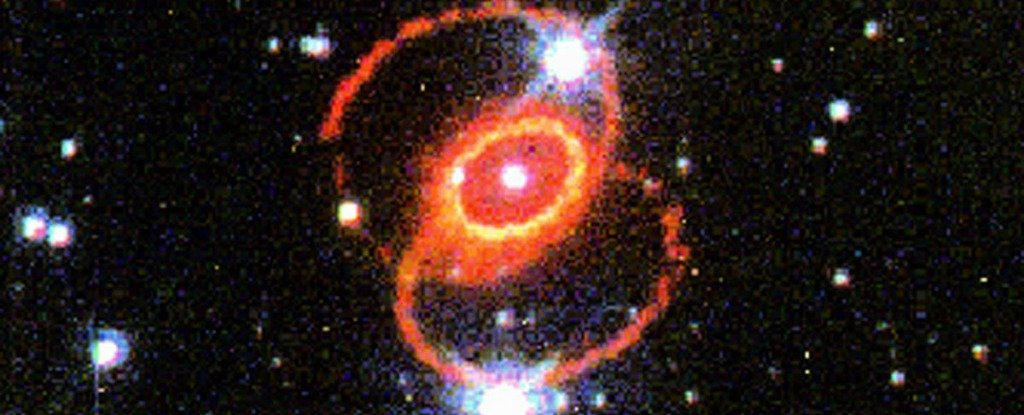New animations released by NASA are recasting a ground-breaking astronomical moment in a whole new light.
On 24 February 1987, astronomers Oscar Dhalde and Ian Shelton witnessed an incredible sight atop a Chilean mountain: a new star in the night sky. Soon, however, they realised it was not a star's birth; rather, it was a blue supergiant meeting its doom.
In that moment, the fusion-powered core of the star - previously called Sanduleak-69° 202 - began to falter. Most astronomers agree the blast happened because the star's core ran low on high-energy fuel, while some believe another star merged with the blue supergiant to trigger the blast.
Either way, the star collapsed under its own gravity, exploded, and spewed radioactive guts all over space - with the power of 100 million suns. We now call the object Supernova 1987A, or SN 1987A.
In the image below, Supernova 1987A's remnants are seen in three different wavelengths of light: infrared (red-orange), visible (green), and X-ray (blue-violet):
It was not only the brightest supernova seen for hundreds of years, but was also the first time astronomers recorded such an event with modern, high-tech instruments.
"Supernova 1987A became one of the best opportunities ever for astronomers to study the phases before, during, and after the death of a star," a video produced by NASA's Chandra X-ray Observatory team said.
The data has provided lots clues about supernovas, including how they forge the new elements that life needs to evolve and distribute them around the universe.
NASA recently commemorated the supernova's anniversary with a bunch of new multimedia, and a few of the images and animations caught our eye.
Zooming in on a supernova's leftovers

This animation gives you a sense of where in the night sky (and just how far away) SN 1987A is located.
The remnants lurk inside the Large Magellanic Cloud, a dwarf galaxy that trails the Milky Way some 168,000 light-years from Earth.
This vast distance means the explosion technically happened 168,000 years in the past, at least relative to where we live. It took that long for the light from the blast to reach us.
Ring of radioactive fire

About once a month over the course of more than 20 years, the Hubble space telescope has photographed SN 1987A and its travelling shock wave. Astronomers continue to compile these images into animations to watch the system evolve.
Starting around the year 2000, they watched the shockwave slam into a 1-light-year-wide ring of gas and dust that the star threw off before its death, creating a brilliant glow.
Researchers now believe the high-speed blast wave is leaving the field of gas and dust, marking the beginning of a major change in its evolution, according to a pre-print study posted to arXiv.org.
3D model of a disaster

This new animation is a computer simulation that used decades of observations to map SN 1987A's explosion in three dimensions.
The model, described in a pre-print study also posted to arXiv.org, can also fast-forward SN 1987A's evolution into the future.
Source: Science Alert


Comments
Post a Comment